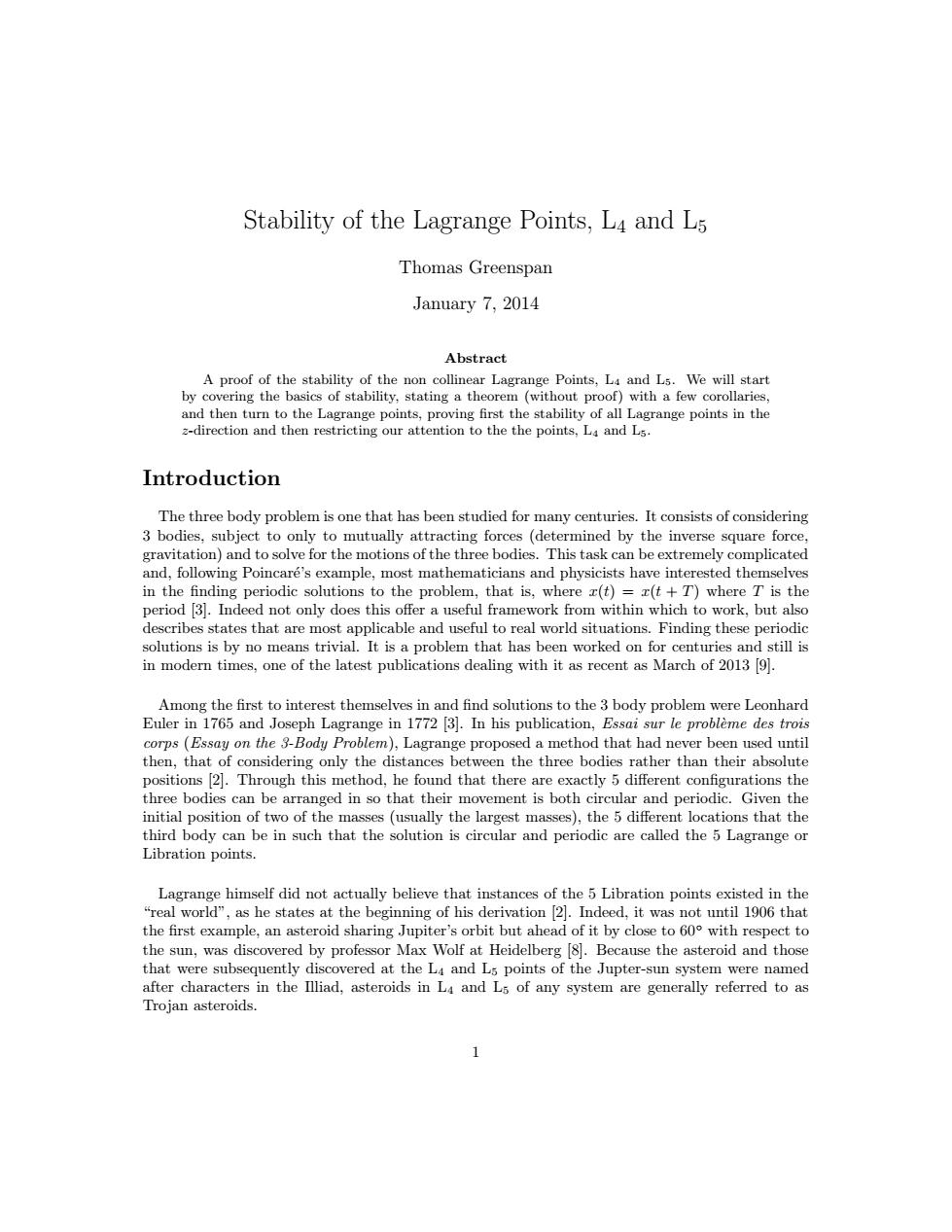正在加载图片...

Stability of the Lagrange Points,L4 and L5 Thomas Greenspan January 7,2014 Abstract A proof of the stability of the non collinear Lagrange Points,L4 and Ls.We will start by covering the basics of stability,stating a theorem (without proof)with a few corollaries, and then turn to the Lagrange points,proving first the stability of all Lagrange points in the z-direction and then restricting our attention to thethe points,L4 and Ls. Introduction The three body problem is one that has been studied for many centuries.It consists of considering 3 bodies,subject to only to mutually attracting forces (determined by the inverse square force, gravitation)and to solve for the motions of the three bodies.This task can be extremely complicated and,following Poincare's example,most mathematicians and physicists have interested themselves in the finding periodic solutions to the problem,that is,where x(t)=x(t+T)where T is the period [3.Indeed not only does this offer a useful framework from within which to work,but also describes states that are most applicable and useful to real world situations.Finding these periodic solutions is by no means trivial.It is a problem that has been worked on for centuries and still is in modern times,one of the latest publications dealing with it as recent as March of 2013 [9]. Among the first to interest themselves in and find solutions to the 3 body problem were Leonhard Euler in 1765 and Joseph Lagrange in 1772 [3].In his publication,Essai sur le probleme des trois corps (Essay on the 3-Body Problem),Lagrange proposed a method that had never been used until then,that of considering only the distances between the three bodies rather than their absolute positions [2].Through this method,he found that there are exactly 5 different configurations the three bodies can be arranged in so that their movement is both circular and periodic.Given the initial position of two of the masses (usually the largest masses),the 5 different locations that the third body can be in such that the solution is circular and periodic are called the 5 Lagrange or Libration points. Lagrange himself did not actually believe that instances of the 5 Libration points existed in the "real world",as he states at the beginning of his derivation [2].Indeed,it was not until 1906 that the first example,an asteroid sharing Jupiter's orbit but ahead of it by close to 60 with respect to the sun,was discovered by professor Max Wolf at Heidelberg [8].Because the asteroid and those that were subsequently discovered at the L4 and Ls points of the Jupter-sun system were named after characters in the Illiad,asteroids in L4 and Ls of any system are generally referred to as Trojan asteroids.Stability of the Lagrange Points, L4 and L5 Thomas Greenspan January 7, 2014 Abstract A proof of the stability of the non collinear Lagrange Points, L4 and L5. We will start by covering the basics of stability, stating a theorem (without proof) with a few corollaries, and then turn to the Lagrange points, proving first the stability of all Lagrange points in the z-direction and then restricting our attention to the the points, L4 and L5. Introduction The three body problem is one that has been studied for many centuries. It consists of considering 3 bodies, subject to only to mutually attracting forces (determined by the inverse square force, gravitation) and to solve for the motions of the three bodies. This task can be extremely complicated and, following Poincar´e’s example, most mathematicians and physicists have interested themselves in the finding periodic solutions to the problem, that is, where x(t) = x(t + T) where T is the period [3]. Indeed not only does this offer a useful framework from within which to work, but also describes states that are most applicable and useful to real world situations. Finding these periodic solutions is by no means trivial. It is a problem that has been worked on for centuries and still is in modern times, one of the latest publications dealing with it as recent as March of 2013 [9]. Among the first to interest themselves in and find solutions to the 3 body problem were Leonhard Euler in 1765 and Joseph Lagrange in 1772 [3]. In his publication, Essai sur le probl`eme des trois corps (Essay on the 3-Body Problem), Lagrange proposed a method that had never been used until then, that of considering only the distances between the three bodies rather than their absolute positions [2]. Through this method, he found that there are exactly 5 different configurations the three bodies can be arranged in so that their movement is both circular and periodic. Given the initial position of two of the masses (usually the largest masses), the 5 different locations that the third body can be in such that the solution is circular and periodic are called the 5 Lagrange or Libration points. Lagrange himself did not actually believe that instances of the 5 Libration points existed in the “real world”, as he states at the beginning of his derivation [2]. Indeed, it was not until 1906 that the first example, an asteroid sharing Jupiter’s orbit but ahead of it by close to 60◦ with respect to the sun, was discovered by professor Max Wolf at Heidelberg [8]. Because the asteroid and those that were subsequently discovered at the L4 and L5 points of the Jupter-sun system were named after characters in the Illiad, asteroids in L4 and L5 of any system are generally referred to as Trojan asteroids. 1